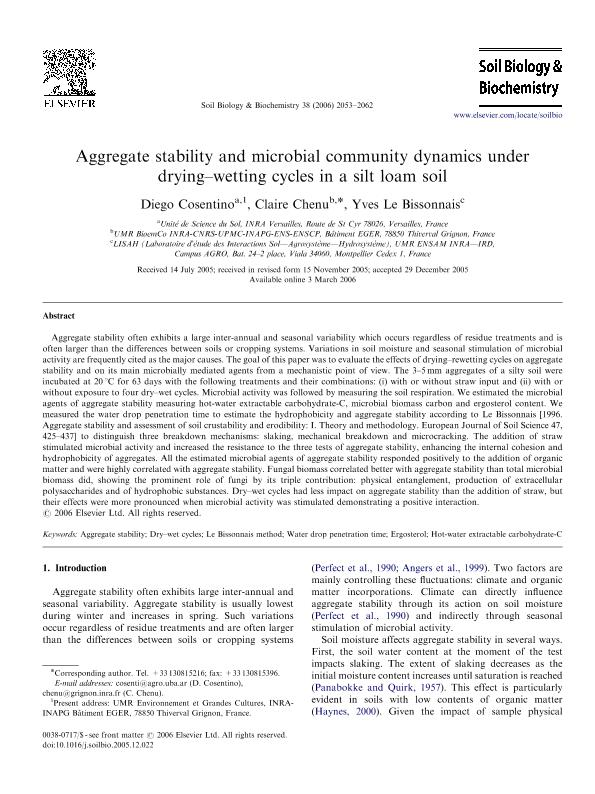Artículo
Aggregate stability and microbial community dynamics under drying-wetting cycles in a silt loam soil
Fecha de publicación:
12/2006
Editorial:
Elsevier
Revista:
Soil Biology And Biochemistry
ISSN:
0038-0717
Idioma:
Inglés
Tipo de recurso:
Artículo publicado
Clasificación temática:
Resumen
Aggregate stability often exhibits a large inter-annual and seasonal variability which occurs regardless of residue treatments and is often larger than the differences between soils or cropping systems. Variations in soil moisture and seasonal stimulation of microbial activity are frequently cited as the major causes. The goal of this paper was to evaluate the effects of drying–rewetting cycles on aggregate stability and on its main microbially mediated agents from a mechanistic point of view. The 3–5 mm aggregates of a silty soil were incubated at 20 °C for 63 days with the following treatments and their combinations: (i) with or without straw input and (ii) with or without exposure to four dry–wet cycles. Microbial activity was followed by measuring the soil respiration. We estimated the microbial agents of aggregate stability measuring hot-water extractable carbohydrate-C, microbial biomass carbon and ergosterol content. We measured the water drop penetration time to estimate the hydrophobicity and aggregate stability according to Le Bissonnais [1996. Aggregate stability and assessment of soil crustability and erodibility: I. Theory and methodology. European Journal of Soil Science 47, 425–437] to distinguish three breakdown mechanisms: slaking, mechanical breakdown and microcracking. The addition of straw stimulated microbial activity and increased the resistance to the three tests of aggregate stability, enhancing the internal cohesion and hydrophobicity of aggregates. All the estimated microbial agents of aggregate stability responded positively to the addition of organic matter and were highly correlated with aggregate stability. Fungal biomass correlated better with aggregate stability than total microbial biomass did, showing the prominent role of fungi by its triple contribution: physical entanglement, production of extracellular polysaccharides and of hydrophobic substances. Dry–wet cycles had less impact on aggregate stability than the addition of straw, but their effects were more pronounced when microbial activity was stimulated demonstrating a positive interaction.
Archivos asociados
Licencia
Identificadores
Colecciones
Articulos(OCA PQUE. CENTENARIO)
Articulos de OFICINA DE COORDINACION ADMINISTRATIVA PQUE. CENTENARIO
Articulos de OFICINA DE COORDINACION ADMINISTRATIVA PQUE. CENTENARIO
Citación
Cosentino, Diego; Chenu, Clarie; Le Bissonnais, Ives; Aggregate stability and microbial community dynamics under drying-wetting cycles in a silt loam soil; Elsevier; Soil Biology And Biochemistry; 38; 8; 12-2006; 2053-2062
Compartir
Altmétricas




